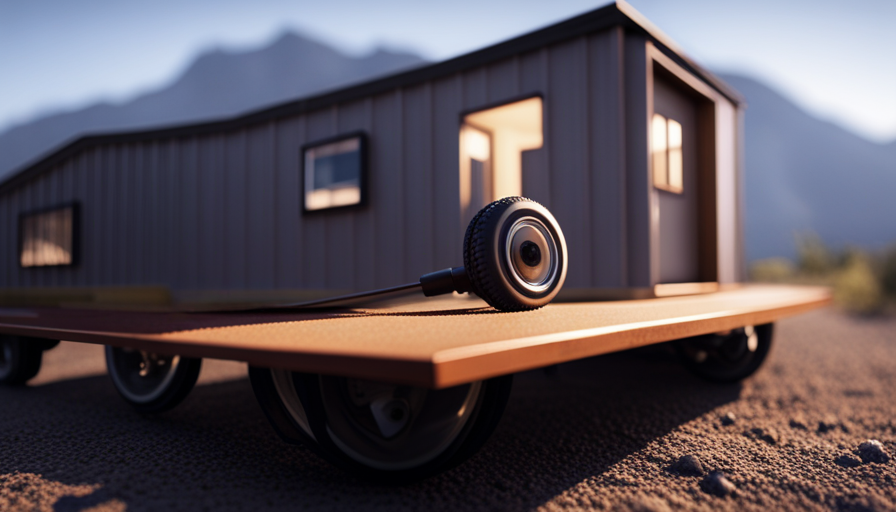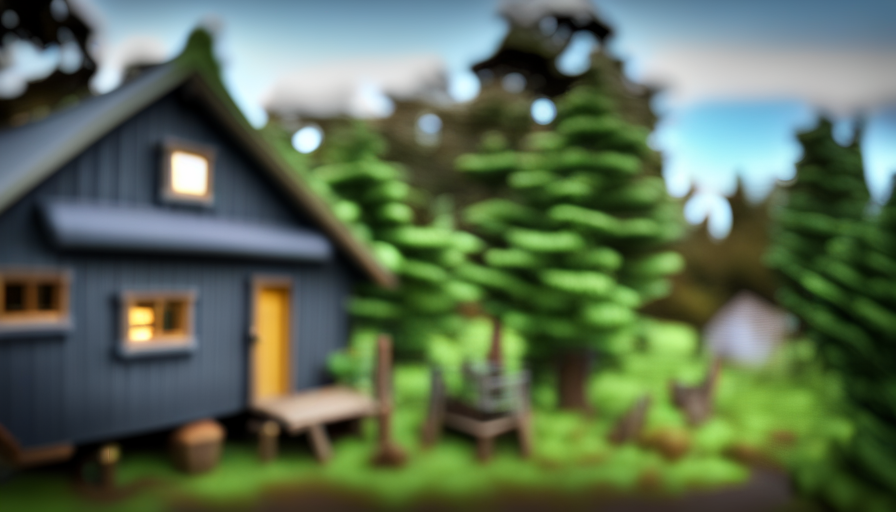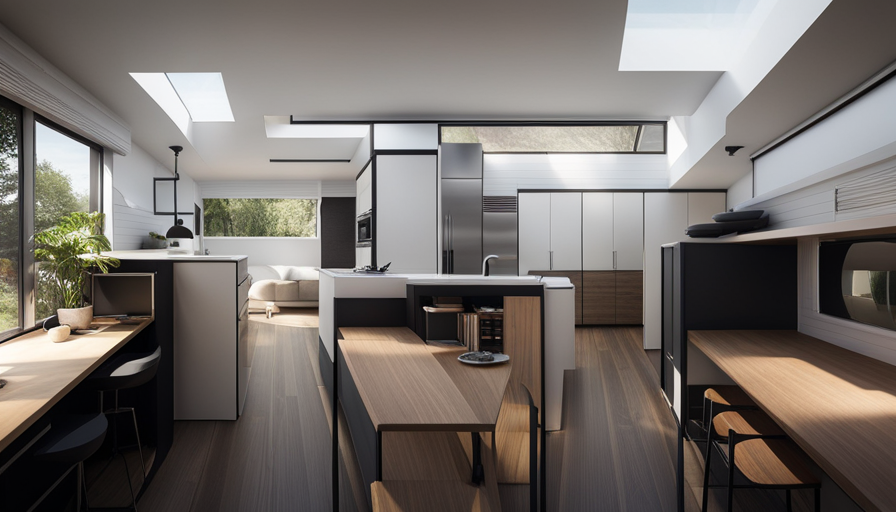When building a small home, it’s important to remember the saying, “Don’t put all your eggs in one basket.” This advice is crucial when considering how to transport your tiny living space. The decision on how many axles are needed for your tiny house is a key factor that can greatly affect the success of your project.
In this article, we will delve into the technicalities and intricacies of determining how many axles are required for a tiny house. From understanding the weight and size of your tiny house to assessing road conditions and legal requirements, we’ll leave no stone unturned in our quest for knowledge. We’ll explore the importance of consulting with professionals and researching different trailer types and sizes. Additionally, we’ll calculate load capacity and distribution to ensure optimal performance on the road.
So buckle up and get ready to dive deep into the world of tiny house axles – because when it comes to towing your dream home, it’s all about finding the perfect balance between safety and functionality.
Key Takeaways
- Number of axles for a tiny house depends on its size, weight distribution, and local towing regulations.
- Consideration must be given to the towing capacity of the vehicle and adherence to safety regulations.
- Different foundation types, such as trailers or concrete slabs, have their own advantages and considerations.
- Assessing terrain, road conditions, and the route is crucial for a smooth and secure towing journey.
Understanding the Weight and Size of Your Tiny House
When considering the weight and size of your tiny house, it’s important to envision how many axles will be needed to support its structure. Size limitations play a crucial role in determining the number of axles required for your tiny house.
The dimensions of your tiny house, including its length, width, and height, must comply with local regulations to ensure safe transportation on public roads. Additionally, weight distribution is another key factor in determining axle requirements. Distributing the weight evenly across the axles helps maintain stability and prevents excessive strain on any one axle.
To determine how many axles are needed for your tiny house, you must calculate its total weight. This includes not only the weight of the structure itself but also all furnishings and personal belongings inside. Once you have this information, you can consult local towing regulations to understand the legal requirements for towing a tiny house.
Considering both size limitations and weight distribution is essential when deciding how many axles are necessary for your tiny house. By adhering to these guidelines, you can ensure that your tiny house meets all legal requirements while providing a safe and stable transport experience.
Determining the Legal Requirements for Towing a Tiny House
Determining the legal requirements for towing a compact dwelling can feel like navigating through a maze of regulations and restrictions. It’s crucial to understand the towing capacity of your vehicle and ensure that it complies with safety regulations.
Here are three key considerations to keep in mind:
-
Towing Capacity: Before embarking on your tiny house adventure, determine the maximum weight that your vehicle can safely tow. Exceeding this limit can not only put you at risk but also lead to legal consequences.
-
Safety Regulations: Familiarize yourself with the specific safety regulations governing towing in your area. This includes understanding the required equipment such as trailer brakes, rearview mirrors, and lighting systems.
-
Permits and Licenses: Depending on the size and weight of your tiny house, you may need to obtain special permits or licenses for towing. Research local transportation agencies to ensure compliance with all necessary paperwork.
By carefully considering these factors, you can confidently navigate the legal landscape of towing a tiny house while ensuring both personal safety and adherence to regulations.
Once you’ve determined the legal requirements for towing, it’s time to move on to considering the type of foundation for your tiny house.
Considering the Type of Foundation for Your Tiny House
One crucial aspect to ponder is the foundation type you choose for your compact dwelling. The type of foundation you select will depend on various factors, including the weight of your tiny house. It’s important to consider these factors carefully to ensure that your foundation is strong and stable enough to support the structure.
To help you make an informed decision, I’ve created a table comparing different types of foundations commonly used for tiny houses:
| Foundation Type | Description |
|---|---|
| Trailer | A mobile foundation that allows for easy transportation |
| Concrete Slab | A solid, permanent foundation made of poured concrete |
| Skids | Wooden beams that allow for mobility and easy relocation |
| Piers | Concrete blocks or pillars that provide elevation and support |
| Screw Piles | Metal screws driven into the ground for stability |
Each foundation type has its own advantages and considerations. For instance, a trailer foundation offers mobility but may require additional anchoring for stability. On the other hand, a concrete slab provides a solid and permanent base but limits mobility.
When considering the type of foundation for your tiny house, it’s essential to take into account not only its weight but also how it will interact with the terrain and road conditions you’ll encounter. This will ensure a safe and secure journey as you move your compact dwelling from one location to another without compromising its structural integrity.
Assessing the Terrain and Road Conditions You’ll Encounter
Assessing the terrain and road conditions you’ll encounter is crucial to ensure a smooth and secure journey for your compact dwelling. When it comes to towing a tiny house, evaluating the cost effectiveness of different trailer options is essential. You need to consider factors such as weight capacity, suspension system, and durability. Researching the impact of weather conditions on towing a tiny house is also vital. Strong winds or heavy rain can pose challenges during transportation, so it’s important to have a trailer that can withstand these conditions.
In addition to trailer considerations, understanding the terrain you’ll be traveling through is crucial. Is the route mostly flat or hilly? Are there any steep inclines or declines? These factors will determine whether you need additional equipment like brakes or wheel chocks.
The condition of the roads you’ll be driving on should not be overlooked either. Potholes, uneven surfaces, or gravel roads can all affect your journey. It’s important to choose a trailer with good suspension and sturdy tires that can handle these road conditions.
By thoroughly evaluating the cost effectiveness of different trailers and researching the impact of weather conditions on towing, you can make an informed decision about which option will best suit your needs. Consulting with a professional engineer or architect will further ensure that your tiny house is equipped for safe transport without compromising its structural integrity.
Consulting with a Professional Engineer or Architect
To ensure the safety and structural integrity of your compact dwelling while on the move, it’s crucial to consult with a professional engineer or architect. Consulting with these experts will provide you with valuable insights and guidance on designing a tiny house that meets all necessary requirements.
Here are three key reasons why consulting with professionals is essential:
-
Expertise in Structural Design: Professional engineers and architects have extensive knowledge in designing structures that can withstand various road conditions and terrain. They can assess your specific needs and incorporate appropriate design elements to ensure stability during transportation.
-
Compliance with Building Codes: Building codes vary from one location to another, and it’s vital to comply with them for safe travel. Professionals can guide you through these regulations, ensuring that your tiny house meets all legal requirements.
-
Maximizing Space Efficiency: By consulting with experts in the field, you can optimize every inch of space within your tiny house without compromising its structural integrity. They can suggest innovative solutions for storage, furniture arrangement, and overall layout design.
Consulting a professional engineer or architect will not only help you create a structurally sound tiny house but also ensure compliance with regulations for safe transportability. Now let’s delve into evaluating the number of rooms and amenities in your tiny house as we continue planning our compact dream home.
Evaluating the Number of Rooms and Amenities in Your Tiny House
Now let’s take a look at how to determine the optimal number of rooms and amenities for your compact dream home. When designing a tiny house, evaluating space utilization is crucial. You want to make every square inch count while still maintaining functionality and comfort. One effective way to do this is by maximizing storage capacity throughout your tiny house.
To help you visualize the possibilities, here is a table that showcases various room options and corresponding amenities:
| Room | Amenities |
|---|---|
| Bedroom | Loft bed, built-in wardrobe, under-bed storage |
| Living Room | Sofa bed, fold-out table, wall-mounted TV |
| Kitchen | Compact appliances, pull-out pantry |
| Bathroom | Shower stall, composting toilet |
| Home Office | Fold-down desk, bookshelves |
By carefully considering these options and prioritizing your needs, you can create a well-designed floor plan that maximizes both living space and storage capacity in your tiny house.
Next, we will delve into researching different trailer types and sizes as it plays an important role in determining the overall mobility and weight capacity of your tiny home.
Researching Different Trailer Types and Sizes
When it comes to finding the perfect trailer for your compact dream home, you’ll want to explore a variety of options and sizes that will provide the ideal mobility and weight capacity for your unique lifestyle.
Researching different trailer types and sizes is crucial in ensuring that your tiny house is securely transported from one location to another. One important aspect to consider is the trailer dimensions. You need to determine the length, width, and height of the trailer to ensure that it can accommodate your tiny house properly.
Another key factor when researching trailers is their towing capacity. This refers to the maximum weight that a particular trailer can safely tow. It’s essential to choose a trailer with a towing capacity that exceeds the weight of your tiny house, including all its contents. Knowing the towing capacity will help prevent any structural damage or accidents during transportation.
By considering both trailer dimensions and towing capacity, you can find a suitable option that meets your needs. Once you have selected a potential trailer, calculating the load capacity and distribution of the axles becomes crucial in ensuring safe transportation for your tiny house without overloading any specific area of the structure.
Calculating the Load Capacity and Distribution of the Axles
Calculating the load capacity and distribution of the axles is essential for ensuring a secure and balanced transportation of your compact dream home, helping to prevent any structural damage or accidents.
When it comes to determining the load capacity, you need to consider both the weight of your tiny house and any additional items that will be inside. This includes furniture, appliances, and personal belongings. By knowing the total weight, you can then select axles that have a sufficient load rating to support this weight.
Weight distribution is another crucial factor to consider. Ideally, you want the weight evenly distributed across all axles to maintain stability during transport. Uneven weight distribution can lead to imbalanced loads, which may cause difficulties maneuvering or even result in axle failure.
To calculate load capacity and distribute weight properly, it is recommended to consult with an engineer or trailer manufacturer who can provide specific guidelines based on your tiny house’s design and dimensions. They will take into account factors such as axle spacing, frame reinforcement, suspension system requirements, and tire ratings.
By ensuring accurate calculations of load capacity and proper weight distribution on your axles, you can confidently transport your tiny house without worrying about structural issues or safety hazards. Planning for future modifications or additions to your tiny house becomes easier when these fundamental aspects are thoroughly addressed in the initial planning stages.
Continuing on with preparations for future adjustments or expansions in mind…
Planning for Future Modifications or Additions to Your Tiny House
Looking ahead, it’s important to consider how you can adapt and enhance your compact dream home to meet your changing needs and desires. Planning for future modifications or additions to your tiny house is crucial in ensuring that it remains functional and comfortable as you grow.
Here are some ideas to help you with your future expansion plans:
-
Create a flexible floor plan: Design your tiny house in a way that allows for easy reconfiguration of spaces. Consider using modular furniture or walls that can be moved or removed when needed.
-
Allocate space for future upgrades: Leave room in your design for potential additions such as extra storage, an additional bathroom, or even a loft area. This will give you the flexibility to expand without major renovations.
-
Budgeting for modifications: Set aside funds specifically designated for future modifications or upgrades. This will help ensure that you have the financial resources available when the time comes.
By considering these factors and incorporating them into your initial design, you can save yourself time, money, and headaches down the road. Seeking advice from experienced tiny house builders and owners can provide valuable insights and guidance on how to plan effectively for future changes in your tiny home journey.
Seeking Advice from Experienced Tiny House Builders and Owners
If you’re seeking guidance on planning for future modifications or additions, experienced builders and owners of compact homes can offer valuable insights to help you make informed decisions.
When it comes to weight distribution in a tiny house, it’s crucial to ensure that the load is evenly distributed throughout the structure. This not only ensures stability during transportation but also prevents any unnecessary strain on the axles. To achieve proper weight distribution, it’s important to carefully consider the placement of heavy items such as appliances and furniture. Additionally, consulting with a professional engineer or builder can provide further guidance on how to distribute weight effectively.
Trailer maintenance is another aspect that should not be overlooked when seeking advice from experienced builders and owners. Regular maintenance of your trailer will not only extend its lifespan but also ensure safe and smooth travels. It’s essential to regularly check for signs of wear and tear, such as rust or loose bolts, and address them promptly. Proper lubrication of moving parts like axles, brakes, and hinges is also critical for optimal performance.
By seeking advice from those who have already navigated the challenges of tiny house living, you can benefit from their expertise in weight distribution and trailer maintenance. Their insights can help you avoid costly mistakes and ensure that your tiny home remains structurally sound for years to come.
Frequently Asked Questions
How do I calculate the load capacity and distribution of the axles for my tiny house?
Calculating the load capacity and axle distribution for a tiny house is crucial, but let’s be honest, it’s not exactly a thrilling task. However, it is essential for ensuring your tiny abode can withstand the weight and maintain stability.
To determine load capacity, consider factors like trailer weight rating and tongue weight. For axle distribution analysis, take into account the placement of heavy items and distribute them evenly across each axle to prevent overloading. Precision is key when it comes to keeping your tiny house on solid ground.
What legal requirements do I need to meet in order to tow a tiny house?
In order to legally tow a tiny house, several requirements must be met.
Firstly, it’s crucial to calculate the load capacity of the axles to ensure they can support the weight of the house and its contents. This involves considering factors such as axle ratings and suspension systems.
Additionally, assessing road conditions is essential for determining if the tiny house can safely navigate various terrains and inclines.
Adhering to these legal requirements ensures a secure towing experience.
How do I assess the terrain and road conditions I will encounter when towing my tiny house?
To assess terrain conditions and choose the right towing vehicle for my tiny house, I need to consider a few factors.
Firstly, I should evaluate the type of terrain I’ll encounter, such as hilly or mountainous areas. This will determine the power and capabilities required from the towing vehicle.
Additionally, I must assess road conditions like potholes or unpaved surfaces to ensure the vehicle can handle them.
Choosing a suitable towing vehicle based on these assessments is crucial for a safe and successful journey.
Should I consult with a professional engineer or architect before building my tiny house?
Consulting with a professional engineer or architect before building my tiny house has both pros and cons.
On the positive side, they can provide expert advice on structural integrity, building codes, and design considerations. They can also assist with cost analysis, helping to ensure that the project stays within budget.
However, their services come at a cost and may increase the overall expense of the project. It’s important to weigh these factors carefully before making a decision.
What are some common modifications or additions people make to their tiny houses in the future?
Some common modifications or additions people make to their tiny houses include adding lofts for extra sleeping space, installing skylights or larger windows for more natural light, and incorporating built-in storage solutions such as shelves, cabinets, and drawers.
Cost-effective ways to increase storage in tiny houses can include utilizing vertical space with tall bookcases or wall-mounted organizers, using multipurpose furniture with hidden compartments, and implementing creative storage solutions like under-bed storage or hanging organizers.
Conclusion
In conclusion, it’s crucial to consider various factors when determining the number of axles for your tiny house.
By understanding the weight and size of your house, as well as legal requirements, foundation type, and road conditions, you can make an informed decision.
Consulting with professionals and researching different trailer types will also aid in calculating load capacity and distribution.
Remember to plan for future modifications and seek advice from experienced builders. As they say, "Measure twice, cut once" – taking these steps will ensure a smooth journey for your tiny home.
Hi, I’m Emma. I’m the Editor in Chief of Tiny House 43, a blog all about tiny houses. While tree houses are often associated with childhood, they can be the perfect adult retreat. They offer a cozy space to relax and unwind, surrounded by nature. And since they’re typically built on stilts or raised platforms, they offer stunning views that traditional homes simply can’t match. If you’re looking for a unique and romantic getaway, a tree house tiny house might just be the perfect option.










